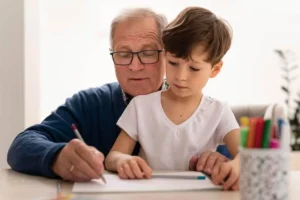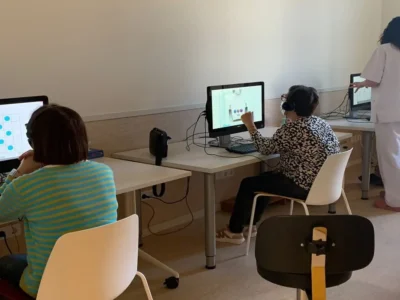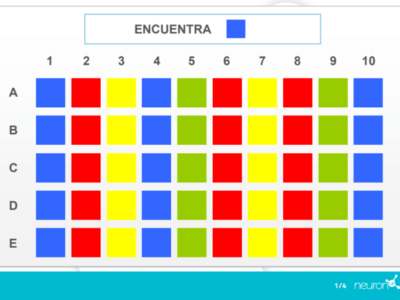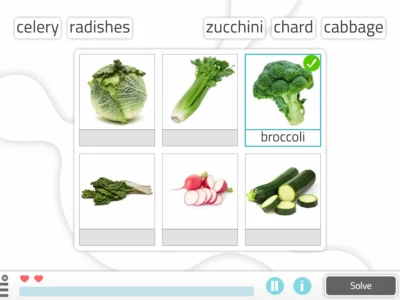In this post, general health psychologist Anna Canals Francés offers us a series of tips to improve our attentional capacity, distinguishing the different types of attention that exist.
One could say that attention is the ability to filter out distractions and concentrate on truly relevant information. That is, it is what allows us to focus on a specific task while ignoring all the stimuli that may be present in our environment (noises, people, images, etc.).
Nowadays, we are surrounded by many stimuli, we are continuously connected and, indeed, many of us have integrated ‘multitasking’ as part of our lives. In terms of attention, therefore, we are making a great effort and errors can easily occur.
How can we improve attention?
There are several strategies to increase attention levels and performance in all areas. One of the most effective is undoubtedly specific exercises and worksheets to improve attention, and there are other methods that can also help us achieve this:
- Controlling environmental conditions: An orderly study or work place, with good lighting conditions and the necessary materials within our reach will allow us to have fewer distractions. Ideally, you should be able to sit in a place where there are no frequent interruptions from other people or noise, although we know that many jobs or some apartments this is not always possible. In these cases, having earplugs for those moments when we need full attention can be very helpful. Special attention should also be paid to mobile phones; setting them to silent mode or very low volume will also help us not to lose focus on what we are doing. Many WhatsApp messages and many calls can wait and, if not, answer only the most urgent ones.
- Getting organized: This part is essential to maintain good attention. Planning what we will do and the order in which we will do things is very important so as not to feel lost or doing a thousand things at once. Also, we will make much better use of our time!
- Along with the previous point, it is advisable to commit to doing one thing at a time to reduce the risk of errors. If new tasks come to mind, rather than leaving everything half-finished and then continuing, you can note them on a sheet to add to the plan later. By having an order, at any moment, if we are interrupted we will also be more aware of what we are doing and will be able to return easily.
- Specific training: Attention training can be followed through psychopedagogical retraining where work is done to increase the time of sustained and/or selective attention, and to strengthen our inner speech to guide us in tasks.
- Hobbies: Especially those that involve searching, such as word searches, spot-the-difference puzzles and Sudokus, can help us maintain and improve our attention.
- Board and card games: They require our attention circuits to be at a high level of activation in order to play a good game. We have many examples: parchís, Monopoly, the famous bingo, poker, mus, escoba, etc.
- Through practices such as relaxation or mindfulness: Finally, we cannot overlook all those practices that lead us to have a more relaxed and focused mind. Stress and hyperactivation make it difficult to concentrate properly. Think, for example, of a time when you were very nervous or stressed—what was your ability to focus on tasks like? Or think of a time when your children were very excited; were they able to pay attention to what they were told or do their homework as on any other day? Practicing relaxation allows us to reduce our restlessness so we can focus on one thing in particular. Mindfulness also helps us to center the mind in the here and now, with full awareness and thus makes it easier to maintain good attention.
Aside from the previous strategies, there are more general tips that will also help us overall with memory, attention and concentration, such as getting enough sleep, exercising regularly, or eating healthily.
Finally, if you’re looking for something more practical and concrete, here are 5 specific exercises to train attention with NeuronUP, which work perfectly for both children and adults.
Types of attention and how to improve them specifically
Attention training or rehabilitation is a process aimed at improving a person’s ability to focus, concentrate and maintain attention on a specific task. This process may be necessary for people who have suffered some type of brain injury, who have attention deficit hyperactivity disorder (ADHD), or who simply want to improve their academic or work performance.
According to the Sohlberg and Mateer model, a dependency relationship between the levels of attention is established, so that the proper functioning of the 4 types of attention depends on the functioning of the others, with sustained attention needing to be trained first before moving on to selective attention and so on.
When rehabilitation is not necessary, but one wants to improve attention, we can practice some exercises on our own.
Below we will see the different types of attention that exist and how we can work on them at home individually:
Sustained attention
It is based on the ability to maintain attention on a task for a prolonged period of time. It is necessary for activities such as reading, studying or performing repetitive tasks.
Training or rehabilitation of the sustained attention focuses on increasing the amount of time we are able to stay concentrated on the task.
Some exercises we can put into practice are the following:
- Tracking exercises: Follow an object with your gaze while it moves, such as a ball or a finger.
- Reading exercises: Read a text for a prolonged period of time without losing concentration.
- Memory exercises: Memorize a list of words or numbers and then recite them in order.
Selective attention
It refers to the ability to focus on a specific task and ignore distractions. Most people cannot maintain attention on a single thing for more than 20 minutes, but they can choose to refocus on the same task several times.
It is necessary for activities like driving, conversing in a noisy environment or performing tasks that require concentration.
You can train selective attention with the following exercises:
- Search exercises: Look for a specific object in an image or in a physical space.
- Listening exercises: Listen to a conversation in a noisy environment and then answer questions about what was heard.
- Discrimination exercises: Distinguish between two similar stimuli, such as two sounds or two images.
Alternating attention
It is the ability to change the focus of attention between different tasks quickly and voluntarily. It is necessary for activities such as driving, following complex instructions, or participating in sports games.
To rehabilitate alternating attention, you can start by performing the following activities:
- Task-switching exercises: Switch between two different tasks, such as writing a sentence, then drawing a shape and repeating the process.
- Game exercises: Play games that require changing the focus of attention between different stimuli, such as video games or board games.
- Another exercise that, in this case, requires no materials is to play a song and tap the table each time you hear a sound pattern you previously decided on.
Divided attention
It refers to the ability to perform two or more tasks at the same time. It is necessary for activities like driving while talking on the phone or taking notes while listening to a lecture.
You can improve divided attention by doing the following activities:
- Shadowing exercises: Listen to a person speak while performing another task, such as taking notes or writing an email.
- Listen to two conversations at once: Try to follow two different conversations happening at the same time.
- Multitasking exercises: Perform two tasks at the same time, such as talking on the phone while cooking.
- Decision-making exercises: Make decisions in situations that require considering different factors, such as playing a simple mobile video game while watching a TV series.
What benefits can be obtained for children and adults?
Improving attention allows children, adolescents, young adults and adults to increase performance and be more effective in school and/or work settings. It also reduces errors from carelessness and forgetfulness and decreases task completion time.
Finally, having a life with more mindful attention helps us be more aware of our actions and live with lower levels of stress since we can have more control over what we are doing.
Bibliografía
- Sohlberg MM, Mateer CA. Effectivenessofanattention-training program. JournalofClinical and Experimental Neuropsychology. 1987;9(2):117–30.
- Sohlberg MM, Mateer CA. ImprovingAttention and ManagingAttentionalProblems. Annalsofthe New York AcademyofSciences. 2006;931(1):359–75.
- The peak performance center – Types of attention (2022).
- Mental Up – Types of attention (2021).
If you liked this article about tips and activities to improve attention, you will surely be interested in these NeuronUP articles:
“This article has been translated. Link to the original article in Spanish:”
Consejos y actividades para mejorar la atención






 How New Technologies Provide Benefits in Cognitive Treatments for Patients with Multiple Sclerosis
How New Technologies Provide Benefits in Cognitive Treatments for Patients with Multiple Sclerosis
Leave a Reply